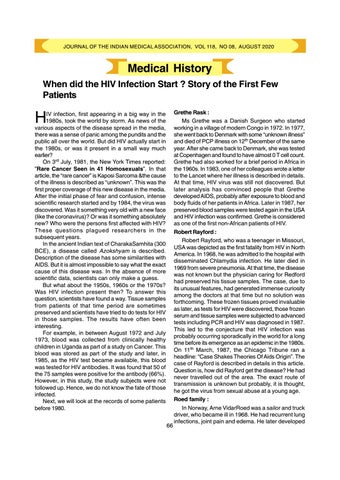JOURNAL OF THE INDIAN MEDICAL ASSOCIATION, VOL 118, NO 08, AUGUST 2020
Medical History When did the HIV Infection Start ? Story of the First Few Patients
H
IV infection, first appearing in a big way in the 1980s, took the world by storm. As news of the various aspects of the disease spread in the media, there was a sense of panic among the pundits and the public all over the world. But did HIV actually start in the 1980s, or was it present in a small way much earlier? On 3rd July, 1981, the New York Times reported: ”Rare Cancer Seen in 41 Homosexuals”. In that article, the “rare cancer” is Kaposi Sarcoma &the cause of the illness is described as “unknown”. This was the first proper coverage of this new disease in the media. After the initial phase of fear and confusion, intense scientific research started and by 1984, the virus was discovered. Was it something very old with a new face (like the coronavirus)? Or was it something absolutely new? Who were the persons first affected with HIV? These questions plagued researchers in the subsequent years. In the ancient Indian text of CharakaSamhita (300 BCE), a disease called Azokshyam is described. Description of the disease has some similarities with AIDS. But it is almost impossible to say what the exact cause of this disease was. In the absence of more scientific data, scientists can only make a guess. But what about the 1950s, 1960s or the 1970s? Was HIV infection present then? To answer this question, scientists have found a way. Tissue samples from patients of that time period are sometimes preserved and scientists have tried to do tests for HIV in those samples. The results have often been interesting. For example, in between August 1972 and July 1973, blood was collected from clinically healthy children in Uganda as part of a study on Cancer. This blood was stored as part of the study and later, in 1985, as the HIV test became available, this blood was tested for HIV antibodies. It was found that 50 of the 75 samples were positive for the antibody (66%). However, in this study, the study subjects were not followed up. Hence, we do not know the fate of those infected. Next, we will look at the records of some patients before 1980. 66
Grethe Rask : Ms Grethe was a Danish Surgeon who started working in a village of modern Congo in 1972. In 1977, she went back to Denmark with some “unknown illness” and died of PCP illness on 12th December of the same year. After she came back to Denmark, she was tested at Copenhagen and found to have almost 0 T cell count. Grethe had also worked for a brief period in Africa in the 1960s. In 1983, one of her colleagues wrote a letter to the Lancet where her illness is described in details. At that time, HIV virus was still not discovered. But later analysis has convinced people that Grethe developed AIDS, probably after exposure to blood and body fluids of her patients in Africa. Later in 1987, her preserved blood samples were tested again in the USA and HIV infection was confirmed. Grethe is considered as one of the first non-African patients of HIV. Robert Rayford : Robert Rayford, who was a teenager in Missouri, USA was depicted as the first fatality from HIV in North America. In 1968, he was admitted to the hospital with disseminated Chlamydia infection. He later died in 1969 from severe pneumonia. At that time, the disease was not known but the physician caring for Redford had preserved his tissue samples. The case, due to its unusual features, had generated immense curiosity among the doctors at that time but no solution was forthcoming. These frozen tissues proved invaluable as later, as tests for HIV were discovered, those frozen serum and tissue samples were subjected to advanced tests including PCR and HIV was diagnosed in 1987. This led to the conjecture that HIV infection was probably occurring sporadically in the world for a long time before its emergence as an epidemic in the 1980s. On 11th March, 1987, the Chicago Tribune ran a headline: “Case Shakes Theories Of Aids Origin”. The case of Rayford is described in details in this article. Question is, how did Rayford get the disease? He had never travelled out of the area. The exact route of transmission is unknown but probably, it is thought, he got the virus from sexual abuse at a young age. Roed family : In Norway, Arne VidarRoed was a sailor and truck driver, who became ill in 1968. He had recurrent lung infections, joint pain and edema. He later developed














